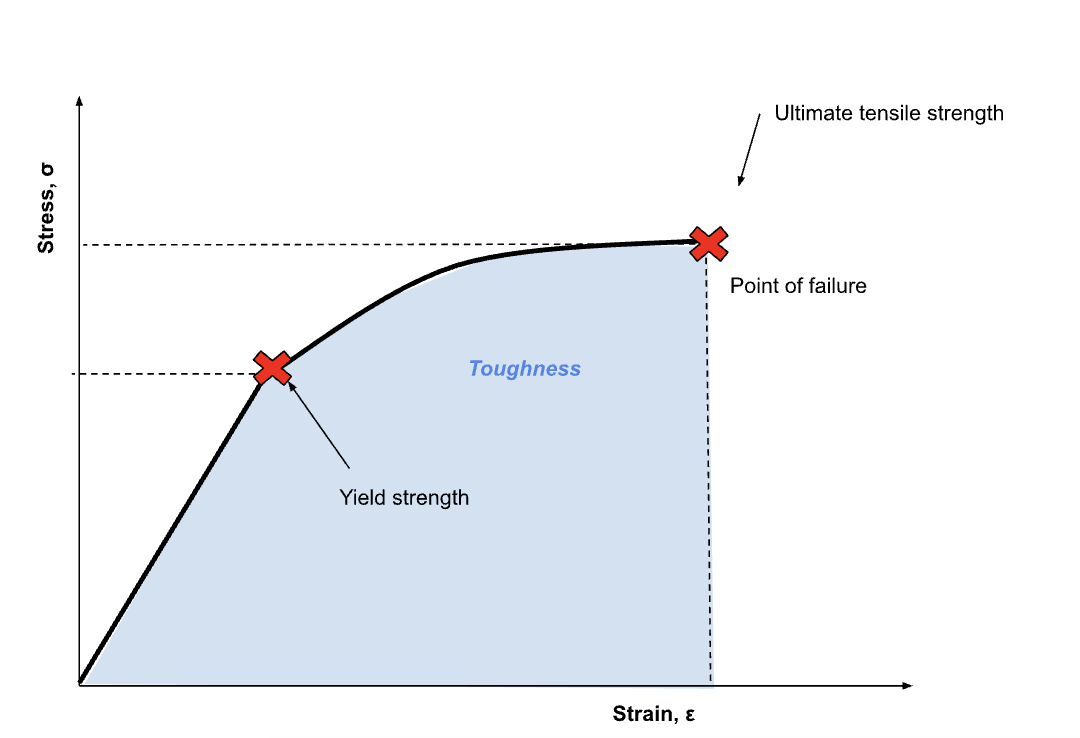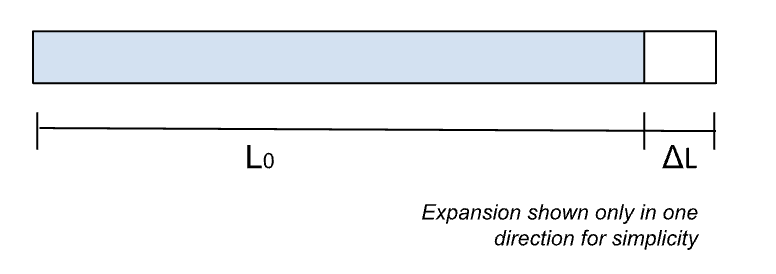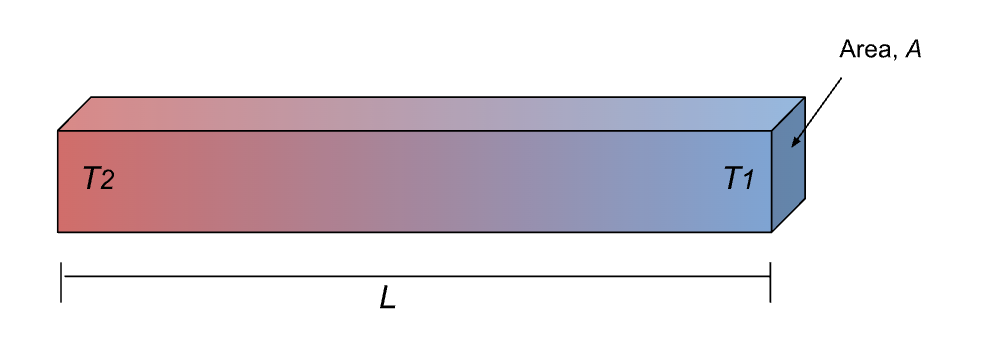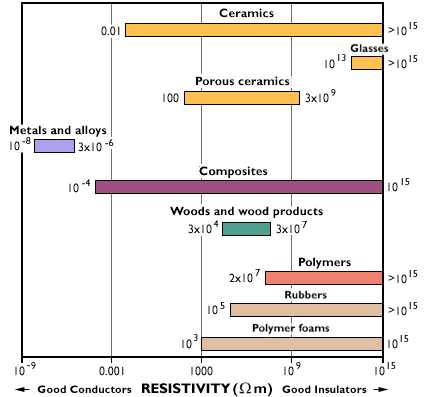What are the properties of engineering materials?
In our last article, we looked at engineering materials and their atomic structure. Now we’re going to dive into the properties of engineering materials. There are several different properties that apply to engineering materials, and we’re going to look at an overview of each of them.
Physical Properties
There are two physical properties we need to be aware of – density and melting temperature.
Density
Density is the amount of mass per unit volume, and its SI unit is kg/m³. The higher the density of a material, the more it will weigh for a specific volume. The symbol given for density is the greek letter rho (ρ).
Melting Temperature
The melting temperature, or melting point, is the temperature where a material changes state from a solid to a liquid. The melting point is a function of pressure, so for standardisation we often quote the melting point for a material at a given pressure (such as 1 atmosphere, ~100kPa).
The melting point of a material is generally driven by the strength of the atomic bonds. The stronger the bond, the more energy required to break them, and hence a higher melting point before the bonds can break and the atoms are free to move.
Mechanical Properties
These properties define how a material acts to an external force, for example impact, bending or shaping. There are quite a few mechanical properties, we’re only going to look into a few or this article would be a book!
Strength
Strength is the ability of a material to withstand a load or force, without failure or permanent deformation. The strength of a material is an important factor in engineering. It defines the amount of load that material can safely be exerted to before failing. It can be important, for example, when calculating the load on a strut in a bridge.
For many materials, there is a linear relationship between the stress (force applied) on a material, and its strain (measure of extension), until a certain point when permanent deformation occurs. This point is known as the materials yield strength.
If the material continues to be exerted to higher forces, it permanently changes shape. Eventually, the material will break or rupture. This point is known as the material’s ultimate tensile strength. It’s common to plot a materials stress vs strain curve, on a graph similar to the below:

Elasticity
The elasticity of a material is a measure of its ability to return to the pre-stressed shape after a load has been applied. If we look back to our stress vs strain graph, the gradient of the straight line below the yield strength is the material’s elastic modulus, otherwise known as the Young’s modulus:

A material with a high Young’s modulus, has high stiffness – it will change its shape only slightly under elastic loading – represented by the Red line above. A material with a low Young’s modulus, has low stiffness and high flexibility. It will deform significantly and still return to its original shape once the load is removed – represented by the green line.
Hardness
The hardness of a material is its ability to resist local deformation caused by indentation or abrasion. You can think of it as the material’s ability to resist scratch or indentation.
Toughness
Toughness of a material is its ability to absorb impact energy and deform plastically without failing by fracture. For example – a crash barrier at the side of a motorway should have a high toughness, it should be able to absorb the impact from the car without breaking.
Refer back to the stress-strain curve above. Toughness is the total energy under the curve before failure (represented by the blue area).

A tough material should be both strong (high yield strength and UTS), but also ductile. For example, ceramics have a high tensile strength, but are very brittle and therefore are not tough. You wouldn’t want a road safety barrier made out of glass!
Thermal Properties
There are two thermal properties we need to be aware of, thermal expansion and thermal conductivity.
Thermal Expansion
This relates to the increase in a material’s volume as its temperature increases. For most materials, the expansion is measured as a distance per unit length. For isometric structures (i.e., the structure is independent of direction and is consistent through the material), the material will expand by the same thermal expansion coefficient in all directions. For structures that are not isometric, you may get different expansion coefficients in different directions.

Thermal conductivity
The thermal conductivity of a material is a measure of its ability to conduct heat. Commonly given the symbol (k, λ, or κ).

Electrical and Magnetic Properties
Finally, we have electrical and magnetic properties. Again, there are a few different properties we need to be aware of.
Conductivity and Resistivity
Similar to thermal conductivity, electrical conductivity defines the ability of a material to conduct electricity. The symbol given for conductivity is σ (sigma), but κ (kappa) (especially in electrical engineering) and γ (gamma) are also commonly used. The SI unit for conductivity is siemens per metre (S/m).
If we take the inverse of conductivity, you get the materials resistivity. When conductivity is low, resistivity is high. When resistivity is low, conductivity is high. Typical resistivity charts for common material family is shown below:

Permeability
Permeability is defined as a measure of how easy magnetic lines of force can pass through the material. A material with high permeability can be more easily magnetised when subjected to an applied magnetic field. Permeability is often symbolised by the Greek letter μ. Its units are Henries per metre (H/m).
Permittivity
The permittivity of a material is the ability of the material to store electrical potential energy whilst subject to an electric field. Knowing the permittivity of a material is critical in electrical engineering when designing capacitors, or parts of a circuit that are expected to introduce capacitance into that circuit. It’s also an important property for materials used in communication and transmission systems.
Permittivity is represented by the greek letter epsilon, ε.
Keep an eye out for our next articles looking at material modes of failure.
Interested in our courses?
You can read more about our selection of accredited online mechanical and industrial engineering courses here.
Check out individual courses pages below:
Higher International Diploma in Mechanical Engineering
Higher International Certificate in Mechanical Engineering
Diploma in Mechanical Engineering
Diploma in Mechanical Technology
Higher International Diploma in Industrial Engineering
Higher International Certificate in Industrial Engineering
Diploma in Engineering Management
Alternatively, you can view all our online engineering courses here.
Recent Posts
From Raw Material to Refined Component: The Role of Drilling and Turning
From Raw Material to Refined Component: The Role of Drilling and Turning Secondary processes are used in manufacturing to further modify the output of primary manufacturing processes in order to improve the material properties, surface quality, surface integrity, appearance and dimensional tolerance. In this blog, we will focus on drilling and turning as secondary manufacturing […]
Behind the Cutter: How Milling Shapes the Future of Manufacturing
Behind the Cutter: How Milling Shapes the Future of Manufacturing Secondary processes are used in manufacturing to further modify the output of primary manufacturing processes in order to improve the material properties, surface quality, surface integrity, appearance and dimensional tolerance. In this blog, we will focus on milling as a secondary manufacturing process. Machining refers […]
What is joining and why is it important in Engineering?
What is joining and why is it important in Engineering? Joining can be considered the third primary manufacturing process, it is an important step in the manufacture of parts with complex shapes, or unusual geometric features. Using the primary processes of casting and forming, it may not be technically or economically feasible to create parts […]

